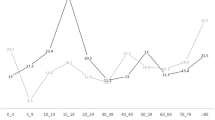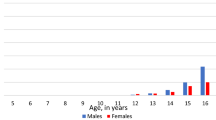Abstract
Overall prevalence of epilepsy ranges from 4 to 10 cases per 1000. Italy lacks recent epidemiological studies on large populations. In the present study, prevalence of epilepsy has been assessed in Tuscany, an Italian Region with 3,750,000 habitants, implementing an algorithm based on administrative data from the Regional Information Health System. To identify patients with epilepsy, we used at least one the following criteria: (a) at least one EEG and at least two dispensations of any antiepileptic drug (AEDS) at a minimum distance of 12 months; (b) at least two dispensations of one “specific” AED (authorized for use only for patients with epilepsy) at a minimum distance of 12 months; and (c) hospital admission for epilepsy or recurrent relapses (cod. ICD-IX-345.*). This algorithm was validated through comparison with lists of true patients with epilepsy and subjects without neurological disorders (gold standard). 35,950 cases were identified. Total crude prevalence was 9.6/1000. Prevalence increased in older patients up to 16/1000 without gender differences. Overall sensitivity of the algorithm was 87.3%, and specificity was 99.9%. This algorithm identifies patients with epilepsy with acceptable sensitivity and specificity and can be used to assess the burden of disease and for monitoring health services.


Similar content being viewed by others
Bibliography
WHO (2006) Neurological disorders: public health challenges, Chap. 3. World Health Organization, Geneva. p 60
Banerjee PN, Filippi D, Hauser WA (2009) The descriptive epidemiology of epilepsy—a review. Epilepsy Res 85(1):31–45. doi:10.1016/j.eplepsyres.2009.03.003
Neligan A, Hauser WA, Sander JW (2012) The epidemiology of the epilepsies. Handb Clin Neurol 107:113–133
Kotsopoulos IA, van Merode T, Kessels FG, de Krom MC, Knottnerus JA (2002) Systematic review and meta-analysis of incidence studies of epilepsy and unprovoked seizures. Epilepsia 43(11):1402–1409
Ministero della Salute. La situazione sanitaria del paese. Malattie del sistema nervoso. http://www.rssp.salute.gov.it/rssp/paginaParagrafoRssp.jsp?sezione=situazione&capitolo=malattie&id=2655
Granieri E, Rosati G, Tola R et al (1983) A descriptive study of epilepsy in the district of Copparo, Italy, 1964–1978. Epilepsia 24:502–514
Gallitto G, Serra S, La Spina P et al (2005) Prevalence and characteristics of epilepsy in the Aeolian Islands. Epilepsia 46:1828–1835
Cossu P, Deriu MG, Casetta I et al (2012) Epilepsy in Sardinia, insular Italy: a population-based prevalence study. Neuroepidemiology 39:19–26
Hauser WA (1995) Recent developments in the epidemiology of epilepsy. Acta Neurol Scand Suppl 162:17–21
Casetta I, Pugliatti M, Faggioli R et al (2012) Incidence of childhood and adolescence epilepsy: a community-based prospective study in the province of Ferrara and in Copparo, Italy, 1996–2005. Eur J Neurol 19:312–316
Holden EW, Thanh Nguyen H, Grossman E, Robinson S, Nelson LS, Gunter MJ, Von Worley A, Thurman DJ (2005) Estimating prevalence, incidence, and disease-related mortality for patients with epilepsy in managed care organizations. Epilepsia 46(2):311–319
Faught E, Richman J, Martin R, Funkhouser E, Foushee R, Kratt P, Kim Y, Clements K, Cohen N, Adoboe D, Knowlton R, Pisu M (2012) Incidence and prevalence of epilepsy among older US medicare beneficiaries. Neurology 78(7):448–453
Giussani G, Franchi C, Messina P, Nobili A, Beghi E, EPIRES Group (2014) Prevalence and incidence of epilepsy in a well-defined population of Northern Italy. Epilepsia 55(10):1526–1533
https://www.ars.toscana.it/it/aree-dintervento/strumenti-e-metodi/indicatori-di-qualita-ed-equita-dellassistenza.html; https://www.ars.toscana.it/it/portale-dati-marsupio-dettaglio.html?codice_asl=9000&preselezione=3
Definition of league against epilepsy (ILAE). http://www.ilae.org/visitors/centre/documents/Definition2014-RFisher.pdf
Bezzini D, Policardo L, Meucci G, Ulivelli M, Bartalini S, Profili F, Battaglia MA, Francesconi P (2016) Prevalence of multiple sclerosis in Tuscany (Central Italy): a study based on validated administrative data. Neuroepidemiology 46:37–42
Ngugi AK, Bottomley C, Kleinschmidt I et al (2010) Estimation of the burden of active and life-time epilepsy: a meta-analytic approach. Epilepsia 51:883–890
Langan SM, Benchimol EI, Guttmann A et al (2013) Setting the RECORD straight: developing a guideline for the REporting of studies conducted using observational routinely collected data. Clin Epidemiol 5:29–31
Franchi C, Giussani G, Messina P, Montesano M, Romi S, Nobili A, Fortino I, Bortolotti A, Merlino L, Beghi E, EPIRES Group (2013) Validation of healthcare administrative data for the diagnosis of epilepsy. J Epidemiol Community Health 67(12):1019–1024
Bell GS, Sander JW (2001) The epidemiology of epilepsy: the size of the problem. Seizure 10(4):306–314
Halatchev VN (2000) Epidemiology of epilepsy—recent achievements and future. Folia Med (Plovdiv) 42(2):17–22
Kairiboriboon K, Bakaki PM, Lhatoo SD et al (2013) Incidence and prevalence of treated epilepsy among poor health and low-income Americans. Neurology 80:1942–1949
Parko K, Thurman DJ (2009) Prevalence of epilepsy and seizures in the Navajo Nation 1998–2002. Epilepsia 50(10):2180–2185
Bell GS, Neligan A, Sander JW (2014) An unknown quantity—the worldwide prevalence of epilepsy. Epilepsia 55(7):958–962
Statistical, epidemiological and economic information, disaggregated for each region are available online at: www.comuni-italiani.it/
Bigal ME, Lipton RB, Cohen J, Silberstein SD (2003) Epilepsy and migraine. Epilepsy Behav 4:S13–S14
Cvetković VV, Strineka M, Knezević-Pavlić M, Tumpić-Jaković J, Lovrencić-Huzjan A (2013) Analysis of headache management in emergency room. Acta Clin Croat 52(3):281–288
Tu K, Wang M, Jaakkimainen RL, Butt D, Ivers NM, Young J, Green D, Jetté N (2014) Assessing the validity of using administrative data to identify patients with epilepsy. Epilepsia 55(2):335–343
Lee SY, Chung SE, Kim DW, Eun SH, Kang HC, Cho YW, Yi SD, Kim HD, Jung KY, Cheong HK, Committee on Epidemiology of Korean Epilepsy Society (2016) Estimating the prevalence of treated epilepsy using administrative health data and its validity: ESSENCE study. J Clin Neurol (Epub ahead of print)
Faught E, Richman J, Martin R, Funkhouser E, Foushee R, Kratt P, Kim Y, Clements K, Cohen N, Adoboe D, Knowlton R, Pisu M (2012) Incidence and prevalence of epilepsy among older US Medicare beneficiaries. Neurology 78(7):448–453
Bakaki PM, Koroukian SM, Jackson LW, Jeffrey M, Albert JM, Kaiboriboon K (2013) Defining incident cases of epilepsy in administrative data. Epilepsy Res 106:273–279
Acknowledgements
The authors received no funding for this study.
Author information
Authors and Affiliations
Corresponding author
Ethics declarations
Conflicts of interest
Gaetano Zaccara received speaker’s or consultancy fees from EISAI, Jansen-Cilag, and UCB Pharma.
Rights and permissions
About this article
Cite this article
Bellini, I., Policardo, L., Zaccara, G. et al. Identification of prevalent patients with epilepsy using administrative data: the Tuscany experience. Neurol Sci 38, 571–577 (2017). https://doi.org/10.1007/s10072-016-2798-0
Received:
Accepted:
Published:
Issue Date:
DOI: https://doi.org/10.1007/s10072-016-2798-0




